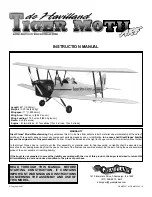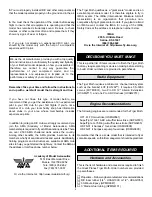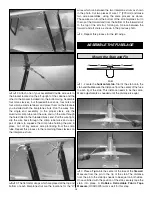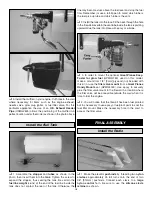
❏
14. Attach the top wing center section by inserting two
4-40 x 3/4" [19mm] socket head cap screws with #4 washers
through the 45-degree metal bracket, the
rear
cabane struts
and the 90-degree brackets. Then install the 4-40 nylon lock
nuts onto the socket head cap screws. Mount the forward
cabane struts to the forward 90-degree brackets by inserting
two 4-40 x 3/4" [19mm] socket head cap screws with #4
washers through the cabane struts and the 90-degree
brackets. Install the 4-40 nylon lock nuts on these screws.
Note
: In order to set the proper dihedral for the top wing, it
will be joined on the model as follows.
❏
15. Test fit the wing joiners into the center section of the
top wing. Slide the two wing panels onto the wing joiners,
and temporarily hold them in place with a few pieces of tape.
(Do not glue yet).
❏
16. Attach the four interplane struts to the top and bottom
wings using 4-40 x 3/4" [19mm] socket head cap screws with #4
washers through the struts and compound-bend metal brackets.
Note that the longer struts are to be mounted in the aft position,
and the shorter struts in the forward position. Temporarily install
the 4-40 nylon lock nuts to hold things in place.
❏
17. Inspect the fit of the top wing to the center section.
They should line up along the bottom edge, and there
should be little or no gap where the wing panels join the
center section. If any misfits are observed, you may loosen
the screws holding the center section to the cabane struts,
make minor adjustments, and re-tighten the screws.
❏ ❏
18.Use 30-minute epoxy to thoroughly coat the root rib
of the right wing half, the outside rib of the center section,
and the wing joiner. Apply a
generous
amount of epoxy into
the wing joiner slots in the wing panel and the center
section. Insert the wing joiner (upright), and slide the wing
panel into place. Working quickly, reattach the interplane
struts and make certain the root rib is in full contact with the
center section and that they align perfectly along the bottom
edge. Hold the wing panel securely to the center section
with strips of masking tape. Wipe away excess epoxy with a
paper towel dampened with alcohol. Do not disturb the wing
until the epoxy has fully hardened.
❏
19. Repeat the above step to attach the top left wing panel.
NOTE:
The flying wires included with the Tiger Moth are
not functional or required for structural integrity.
❏ ❏
1. Use the photos above as a reference guide in
assembling the flying wires. Using the
coil of the flying wire
,
six
2-56 clevises
, six
2-56 threaded brass ends
, six
2-56
nuts
, eight
aluminum crimp tubes
and six
silicone clevis
retainers
, make the flying wires for the right wings first. Start by
assembling two clevises with the threaded brass ends and
nuts. Note that the single ends of the wire sets are located next
to the fuse. Cut four lengths of wire from the coil 17” [432mm]
long and attach four of them to two of the threaded brass ends
using four aluminum crimp tubes as shown in the photo.
Install Flying Wires
11


























